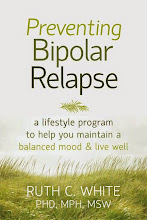BIPOLAR RESEARCH UPDATE
The genes that influence our circadian rhythms and sleep cycles also influence the clinical features and age of onset of bipolar disorder.
Benedetti, F., Dallaspezia, S., Colombo, C., et al., (2008). A length polymorphism in the circadian clock gene Per3 influences age at onset of bipolar disorder. Neuroscience Letters, 14, 445(2), 184-187.
Cannabis abuse causes bipolar-related psychosis to start an average of three years earlier than for people who did not abuse cannabis.
Ongur, D., Lin, L., & BM Cohen (2009). Clinical characteristics influencing age at onset in psychotic disorders. Comprehensive psychiatry, 50(1), 13-19.
Treating even minor depressive symptoms after a first manic episode is integral to recovery after depression following a first manic episode because only depression was found to be related to functional outcomes at 6 months post a manic episode.
Kauer-Sant’anna, M, Bond, DJ, Lam, RW, Yatham, LN (2009). Functional outcomes in first-episode patients with bipolar disorder: a prospective study from the Systematic Treatment Optimization Program for Early Mania project. Comprehensive Psychiatry, 50(1), 1-8.
A 16-week trial found that aripiprazole seems to show promise as an adjunctive treatment or monotherapy in people with bipolar disorder who are unresponsive to mood stabilizers. Akathisia (inner restlessness) and slight weight gain were the main side effects. However, double-blind, placebo-controlled studies are necessary to measure the drug’s efficacy, tolerability and safety for bipolar patients.
Mazza, M, Squillacioti, MR, Pecora, JD, et al (2008). Beneficial acute antidepressant effects of aripiprazole as an adjunctive treatment or monotherapy in bipolar patients unresponsive to mood stabilizers: results from a 16-week open-label trial. Expert opinion on pharmacotherapy, 9(18), 3145-9.
A study of the effectiveness of acute treatment with interpersonal and social rhythm therapy on occupational functioning found that despite the lack of statistical significance, there was more improved occupational functioning than with a pscyhoeducational and supportive approach with no emphasis on functional capacity.
Frank, E, Soreca, I, Swartz, HA et al. (2008). The role of interpersonal and social rhythm therapy in improving occupational functioning in patients with bipolar I disorder. American Journal of Psychiatry, 165(12), 1559-65.
Thursday, January 8, 2009
Subscribe to:
Post Comments (Atom)





I had bipolar disorder several years ago and I cured it with light therapy and a high salt diet (isotonic). The light therapy has an obvious connection to the circadian clock – it lengthens daylight. But it took me a while to find how salt was connected. I discovered that in the evening my urine sodium level rose dramatically. This implies that my sodium blood level falls at this time, probably in preparation for sleep. When my sodium level goes below a certain level it causes a condition called hyponatremia which includes mental symptoms. The high salt diet prevents me from going below that critical level and the extra evening light therapy slows down the loss of sodium during the evening hours. Insidently this also cured my anxiety attacks.
ReplyDeleteThe information you provide is very helpful. Penyebab dan Gejala Demam Berdarah atau DBD Cara Menyembuhkan Penyakit Gula
ReplyDeleteI have long been looking for this information, and eventually I found your website. Cara Menyembuhkan Gagal Jantung Cara Mengatasi Asam Urat
Thank you so much for sharing of information. Cara Menyembuhkan Penyakit Kanker